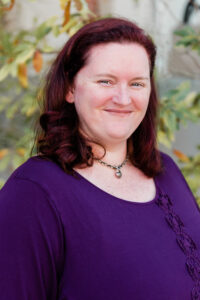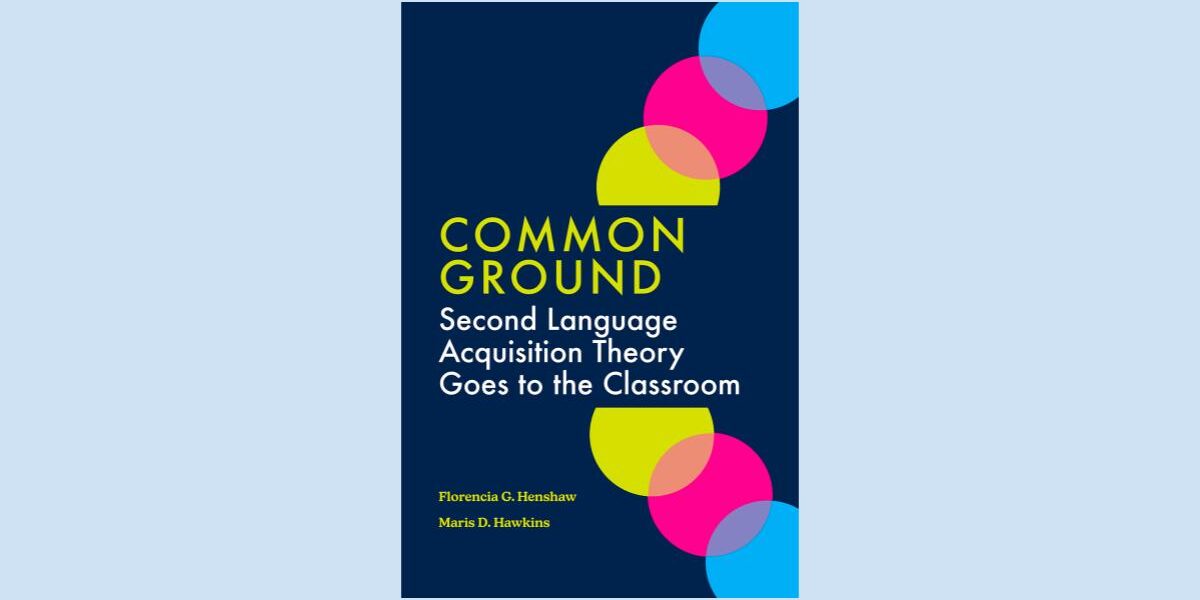Book Review: Common Ground: Second Language Acquisition Goes to the Classroom
By Amanda Romjue, Emory & Henry College

DOI: https://www.doi.org/10.69732/IMJB1731
Henshaw, Florencia G., & Hawkins, Maris D. (2022). Common Ground: Second language acquisition goes to the classroom. Hackett Publishing Company: Indianapolis.
Common Ground Connects Theory & Practice
Common Ground: Second Language Acquisition Theory Goes to the Classroom is the book everyone is talking about. The text was written by Florencia G. Henshaw and Maris D. Hawkins. Henshaw, the Director of Advanced Spanish at the University of Illinois at Urbana-Champaign, has become well known in the field of language learning through her social media presence, YouTube channel, and webinar presentations. Hawkins teaches Spanish at the Capitol Hill Day School in Washington, D.C. In their new book, Henshaw and Hawkins present the essential research about language acquisition clearly and concisely and take the next step to connect research and theory with many detailed examples of practice and assessment.
Layout and Contents
There are three sections of the text: SLA and Pedagogy; Interpretive Communication; and Presentational and Interpersonal Communication. In the first section, SLA and Pedagogy, the authors highlight Guiding Principles in Chapter 1 and Goals and Assessment in Chapter 2. The second section, Interpretive Communication, discusses Input in Chapter 3 and Reading, Listening, Viewing in Chapter 4. The final section, Presentational and Interpersonal Communication, focuses on Output in Chapter 5 and Interaction in Chapter 6. The organization of the topics takes readers through what they need to know about how second language acquisition (SLA) works and what that knowledge looks like applied in specific examples. Each chapter ends with questions and activities to help readers reflect on what they have learned and how they can use it in their own contexts.
What Do I Need to Know?
In this first section of each chapter the authors focus on concise and understandable explanations and comparisons of various second language acquisition theories including, but not limited to, the comprehensible input hypothesis (Krashen); the output hypothesis (Swain); and the interaction hypothesis (Long). One particular topic that stands out is their clear and concise discussion in chapter 2 on proficiency and performance. Assessment is treated throughout the text in practical ways as most teachers have to assign a grade but struggle to make that grade reflect the progress their learners are making. For example, the authors draw focus to the purposes of assessment as more than a grade, but as a way to “provide learners with the support they need based on their performance” (p. 37). The discussions of SLA theories and assessments alone make this a great text for language teaching methodology courses or a refresher for practicing language teachers, but that is only the beginning. There is more practical application of what we know about how second languages are learned in the next section.
What Does it Look Like in the Classroom?
The second section of each chapter is extremely useful, with many examples of how theory becomes practice. Henshaw and Hawkins share many activities that can be easily adapted to different languages and language learning spaces at all levels. There are NCSSFL/ACTFL Can-Do statements, activities in all modes of communication, and examples of rubrics. The authors focus on realistic expectations of what novice learners, for example, should be able to do and move away from some notion of grammatical perfection deemed unrealistic for these learners. For example, they show how an Integrated Performance Assessment (IPA) can be adapted for novice learners by using fewer of “the usual questions you might see in the interpretive section” and in the interpersonal section including “the instructor since novice learners are not yet able to carry out a conversation on their own” (p. 50). There are a variety of ideas for novice, intermediate, and advanced learners. These activities are very detailed including suggestions of what to say and what to show students in order to keep the focus on proficiency. For example, in a thematic unit for novice level learners, Can-Do statements focus on level-appropriate tasks like “I can read an infographic…,” “I can ask and answer simple questions…,” and “I can make a list…” (p. 47). The activities demonstrate various strategies, such as using visuals and binary-choice questions, to help learners “engage meaningfully with the language” (p. 13). The thematic unit described here focuses on Self-Care and Healthy Habits at a Novice-high level. It has been especially helpful in thinking through how to bring my own practice to a place of greater relevance to my, mostly first year, college students. These materials and details make the book an invaluable resource for anyone planning and/or facilitating language learning experiences.
Now That You Know
The final part of each chapter features Discussion and Expansion Questions and Observation and Application Activities. Here readers can reflect on what they are learning and extend that learning beyond the pages of this text. These sections help readers take their learning and evaluate what it means within their own context and plans. For example, a discussion and expansion question at the end of the second chapter features a rubric and asks readers to evaluate it based on “the characteristics of good rubrics” discussed in chapter two (p. 61-62). The observation and application activities then encourage readers to research and evaluate rubrics they find online, observe beginning or intermediate-level courses with guiding questions to answer, and finally to create an adapted IPA for their specific context (p. 63-64). It takes that needed next step to help readers move toward better outcomes for their own learners.
Reflecting
This text is short and concise. It is organized in a manner that facilitates either a quick read or a more in depth one. The tone of the text is engaging; it is humorous and relatable, and hard to put down. If your goal is to develop learners’ proficiency, this text provides a roadmap to help get them there. If the goal is to train future language teachers, this book should be a required text for that course. If the goal is to improve or move to a proficiency-based curriculum, this is the book to read. It gives us language and research so we can more successfully advocate for curricular changes that will get learners speaking the target language. A colleague recently expressed that reading the book helped them to understand that the changes we are discussing are coming from a place of research and understanding. This is an excellent book and I highly recommend it to anyone involved in language learning experiences.
Next Steps
There are a multitude of ways to engage with this text. It can be read with colleagues, as part of a book club, or used as part of a Personal Learning Network (PLN). The authors have various resources, some of which are linked below. The International Center for Language Studies (ICLS) chose this text as their upcoming book club reading. This is only to mention a few instances to engage more closely with these topics and authors.
- Maris Hawkins’ blog – https://marishawkins.wordpress.com/
- Florencia Henshaw’s website – https://sites.google.com/view/techforlangteaching
- Unpacking Pedagogy YouTube channel – https://www.youtube.com/c/Unpackinglanguagepedagogy
- Unpacking Pedagogy Podcast – https://anchor.fm/unpackinglanguagepedagogy
- Information about the text from the publisher: https://hackettpublishing.com/modern-languages/common-ground-second-language-acquisition-theory-goes-to-the-classroom
- Companion website – https://hackettpublishing.com/common-ground-resources
Have you found the Common Ground yet? You can get a copy of the paperback or eBook version of the text through the publisher link above or from your favorite book store. Finished reading it? Come join the conversation on social media with the official hashtag #UnpackingCommonGround and connect directly with the authors on Twitter: @Prof_F_Henshaw and @Marishawkins.


Great summary, Amanda R.! “Common ground” is exactly what many language teachers and language programs have needed to find in recent years. As a teacher educator who has seen language teachers and programs transform as a result of CI and comprehension-based approaches, I see the references to those approaches and also the echoes of many interactions with teachers striving to understand the connections to SLA and also struggling to keep collaborating with other teachers who are more “traditional” or who “believe in grammar.” Promoting world languages and multilingualism today is hard enough when you are not fighting with your colleagues in every meeting about planning, curriculum, and assessment. The content, structure, and style of the book are very helpful and accessible in and of themselves, but to me what is really priceless is that they have managed to wade into what has become a battleground and turned the tide. Muchas gracias to Florencia and Maris for that!
Thank you so much! I am humbled and honored by this wonderful review.
You’re welcome. I’m so glad you liked it.